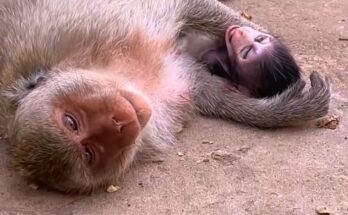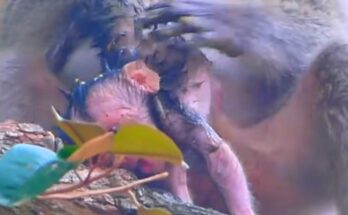In a tragic encounter between wildlife and human infrastructure, a monkey’s life changed forever when it came into contact with a live electrical wire. What began as a typical day of foraging and movement through the trees ended in a devastating electric shock that left the animal severely injured, frightened, and forever altered. This is the heartbreaking story of a monkey now facing a lifetime of pain, struggle, and uncertain survival.
Electric shocks are a growing threat to primates living in or near human settlements. As forests shrink and power lines cut across traditional monkey pathways, the likelihood of accidental electrocution rises dramatically. For a monkey, a power line may look no different than a tree branch or vine. It’s an understandable mistake—one that often ends in death or permanent injury.
This particular monkey, a young adult known to local wildlife observers, had often been seen traveling with its troop across a forested area now fragmented by roads, farms, and utility poles. On the day of the accident, it attempted to cross a power line strung between two trees—likely in search of food or trying to keep up with its group. In an instant, it made contact with a live wire. The electric current surged through its body, knocking it violently to the ground.
The aftermath was horrifying. The monkey suffered severe burns to its hands, feet, and face. Its fur was singed, and the shock left it disoriented and in intense pain. Local witnesses described the animal screaming and writhing before finally collapsing in silence. Though it miraculously survived the initial shock, the injuries were grave and life-changing.
Recovery for a wild animal after such trauma is difficult, especially without veterinary intervention. Burned limbs can become infected, and nerve damage often results in chronic pain or partial paralysis. For monkeys, who rely on strong, agile limbs to climb, feed, and defend themselves, even minor injuries can lead to social exclusion or death. A disabled monkey cannot easily keep up with its troop, and may be left behind, vulnerable to predators or starvation.
In some rare cases, rescuers or wildlife rehabilitators are able to intervene. Monkeys that survive electric shock may be brought into care, where they receive treatment, pain relief, and—if possible—surgery. But many are not so lucky. They are left to suffer in silence, their injuries slowly worsening as they try to adapt to a life they are no longer physically equipped to navigate.
This tragedy is not just about one monkey. It reflects a broader problem: the growing conflict between urban expansion and wildlife survival. As power lines, roads, and buildings encroach on natural habitats, animals are forced into dangerous interactions with human structures. Without measures like insulated wiring, monkey bridges, or protected corridors, these accidents will continue.
The story of this injured monkey is a sobering reminder of the unseen toll human development can take on wildlife. It challenges us to look beyond convenience and growth, and to consider the quiet suffering of those who share our world—creatures whose only mistake was crossing into a space that once belonged to them.


